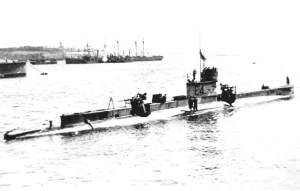HMS E4

| |
| History | |
|---|---|
| Name | HMS E4 |
| Builder | Vickers, Barrow |
| Cost | £101,900 |
| Laid down | 16 May 1911 |
| Launched | 5 February 1912 |
| Commissioned | 28 January 1913 |
| Fate | Sold for scrapping, 21 February 1922 |
| General characteristics | |
| Class and type | E class submarine |
| Displacement |
|
| Length | 178 ft (54 m) |
| Beam | 15 ft 5 in (4.70 m) |
| Propulsion |
|
| Speed |
|
| Range |
|
| Complement | 31 |
| Armament | 4 × 18 in (457 mm) torpedo tubes (1 bow, 2 beam, 1 stern) |
HMS E4 was a British E class submarine built by Vickers, Barrow-in-Furness, costing £101,900. E4 was laid down on 16 May 1911, launched on 5 February 1912 and commissioned on 28 January 1913. On 24 September 1915 E4 was attacked by the German airship SL3. On 15 August 1916, she collided with sister ship E41 during exercises off Harwich. Both ships sank and there were only 14 survivors, all from E41. Both boats were raised, repaired and recommissioned. She was sold on 21 February 1922 to the Upnor Ship Breaking Company.
Design
The early British E-class submarines, from E1 to E8, had a displacement of 652 tonnes (719 short tons) at the surface and 795 tonnes (876 short tons) while submerged. They had a length overall of 180 feet (55 m) and a beam of 22 feet 8.5 inches (6.922 m), and were were powered by two 800 horsepower (600 kW) Vickers eight-cylinder two-stroke diesel engines and two 420 horsepower (310 kW) electric motors.[1][2] The class had a maximum surface speed of 16 knots (30 km/h; 18 mph) and a submerged speed of 10 knots (19 km/h; 12 mph), with a fuel capacity of 50 tonnes (55 short tons) of diesel affording a range of 3,225 miles (5,190 km; 2,802 nmi) when travelling at 10 knots (19 km/h; 12 mph), while submerged they had a range of 85 miles (137 km; 74 nmi) at 5 knots (9.3 km/h; 5.8 mph).[1]
The early 'Group 1' E class boats were armed with four 18 inches (460 mm) torpedo tubes, one in the bow, one either side amidships, and one in the stern; a total of eight torpedoes were carried. Group 1 boats were not fitted with a deck gun during construction, but those involved in the Dardanelles campaign had guns mounted forward of the conning tower while at Malta Dockyard. [1]
E-Class submarines had wireless systems with 1 kilowatt (1.3 hp) power ratings; in some submarines, these were later upgraded to 3 kilowatts (4.0 hp) systems by removing a midship torpedo tube. Their maximum design depth was 100 feet (30 m) although in service some reached depths of below 200 feet (61 m). Some submarines contained Fessenden oscillator systems.[3]
Crew
Her complement was three officers and 28 men.[3]
References
- ^ a b c Akerman, P. (1989). Encyclopaedia of British submarines 1901–1955. p.150. Maritime Books. ISBN 1-904381-05-7
- ^ "E Class". Chatham Submarines. Retrieved 20 August 2015.
- ^ a b Innes McCartney; Tony Bryan (20 February 2013). British Submarines of World War I. Osprey Publishing. pp. 11–12. ISBN 978-1-4728-0035-0.
Bibliography
- Submarines, War Beneath The Waves, From 1776 To The Present Day, by Robert Hutchinson
- The Royal Navy Submarine Service, A Centennial History, by Antony Preston
- Colledge, J. J.; Warlow, Ben (2006) [1969]. Ships of the Royal Navy: The Complete Record of all Fighting Ships of the Royal Navy (Rev. ed.). London: Chatham Publishing. ISBN 978-1-86176-281-8.
External links
